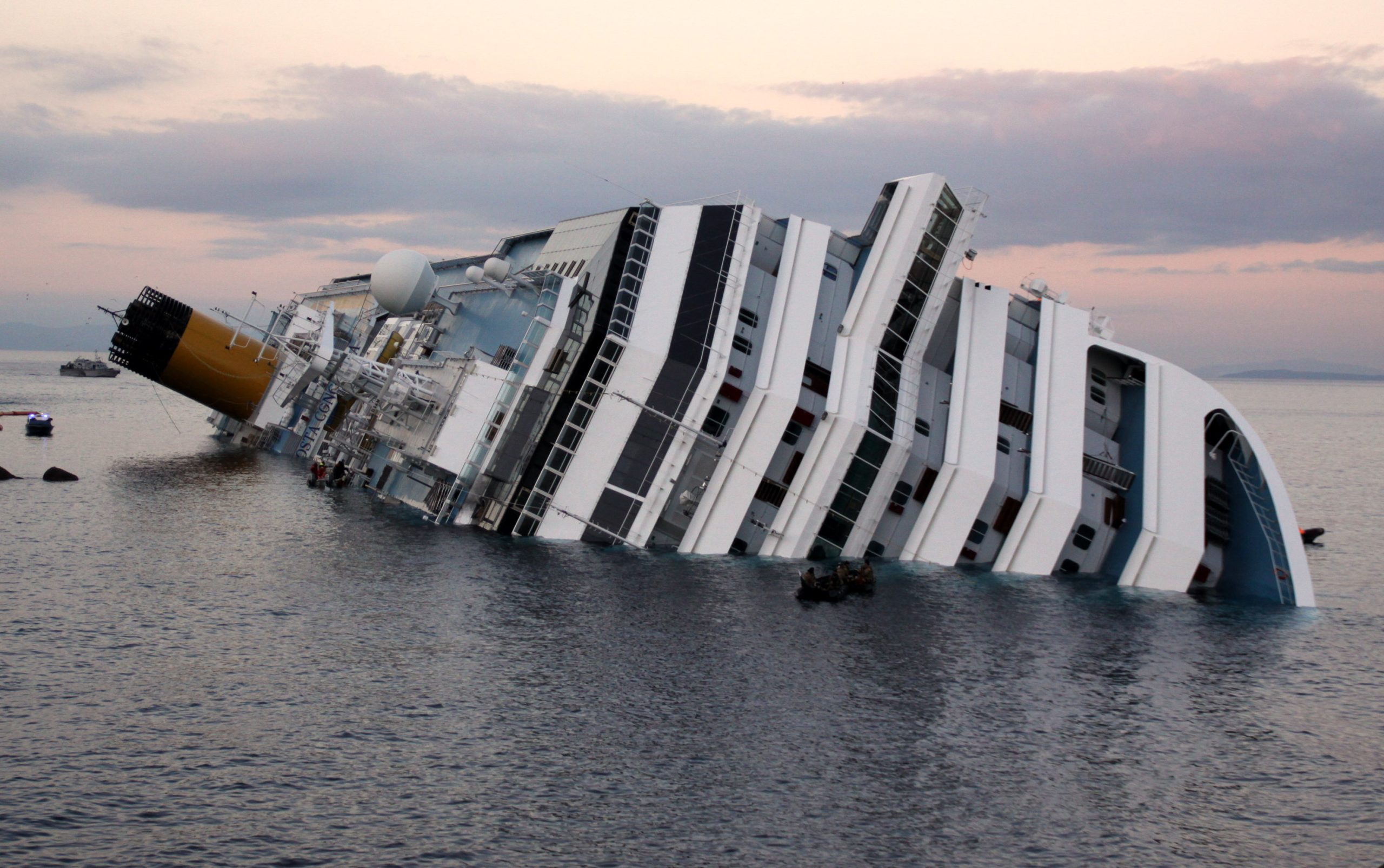by Thomas Mackinson
A team of ten crisis experts from the largest public relations companies in the world. These are the forces placed on the field by Costa and its parent company Carnival Corporation to manage communications in the Concordia disaster at Giglio Island.
It was an inevitable choice considering the proportions and complexity of the tragedy that multiplied the emergency fronts from the evening of 13 January, when the telephone calls took place between the captain, Francesco Schettino, the company and the Port Authority of Leghorn, which later became the subject of the official inquiry. These are the elements that should enable the Prosecutor’s Office of Grosseto to determine the civil and criminal liability. But there is another front on which Costa has had to proceed in full emergency, and that is the broadened, global communication of the narration of events.
The ability to manage this is decisive for the Italian company, for Carnival and for the entire cruise business sector, which fears a rash of cancellations because of the photograph that is stamped in everyone’s brain of the dreamship lying on its side on the rocks, half sunk in the water. But something isn’t working. In a matter of hours the world has its TV cameras trained on that picture. And the company isn’t there. The first to arrive, at 3 pm the next day, apologizing for the delay, is the general director Gianni Onorato.
Another three long days go by in silence, accompanied by uncertainty with regard to the management of information, even from the operational standpoint. Costa does not set up an information point at the site and provides a single number where callers can request information, but not toll-free.
Information is made available in Italian only, despite the fact that the victims are of 19 different nationalities. The company’s official website could have been the ideal information channel but while it publishes messages of condolence it also continues to promote its cruises and publish photos of happy vacationers enjoying their holidays. What is worse, after being bombarded by accesses from all over the world, it crashes and stays down for two days.
The social networks, which could have been a more rapid vehicle for information in real time were used clumsily. Tweets were posted with the wrong hashtag (#): they were written with #concordia while the people of Twitter were talking with #costaconcordia. It seems like a minor detail, but this choice reduced the radius of action of Costa’s communications. Then came the questionable episode of the cancellation from the official Costa blog of the post in which the company thanks Schettino for his “inchino” (salute) to Giglio Island, a practice that was considered a festive occasion on 30 August 2010 and that after the tragedy officially became an «irresponsible and unauthorized act».
That is not a small matter, since the company will soon have to defend itself, among other things, from the charge of having urged that little excursion off-course for promotional purposes. There has been talk of misjudgment, inadequacy of the communications protocols, even of intentional reticence and suspicion on the part of the company in furnishing information about the accident. Then, however, something happened. The whole picture changed.
Starting 15 January, a team of professionals from the three largest public relations agencies in the world started working alongside the institutional communications office of Costa headed by Fabrizia Greppi. Eight of its members work for Burson-Marsteller, the reference for the sector when it comes to crisis communications. The most expert account, the managing director Fabio Caporizzi, took charge and sent two professionals to Giglio Island and two to Genoa where the company set up a special operations room to assist the crew and passengers of the Concordia.
The other four gravitate between Rome and Milan. The team was bolstered by the addition of Wanda Gatti from Edelman, another big in the sector that handles product communications for Costa, as well as a member of Fleishman Hillard, the agency that handles economic communications for Carnival. None of them are talking. They hang up at the first indiscrete question. The facts are what are doing the talking.
After three days of silence the chairman of Costa Crociere Pier Luigi Foschi appeared on camera and stopped minimizing, apologized, reassured the guests, relatives of the victims and crew, about the insurance coverage. He cleared up any doubt about the company’s desire to collaborate with the authorities, suspended Captain Schettino, denied him any legal defense and declared himself an injured party, also recommending «taking absolute power away from the captain».
He repeats for the clients that Costa vessels are safe, and launches a strong message to the parent company Carnival and to the sector: “Certainly, I’m worried about the business but this will not by the 9/11 of cruises”. Then, to top it off, he breaks down in tears and reveals the human side of the company. The headquarters of Costa in Genoa becomes an active structure in furnishing assistance to passengers and crew. The measure of its commitment reaches out to a thousand Carnival employees. In communications and interviews, there is more emphasis on the many positive heroes, on the crew that distinguished itself for acts of heroism.
A total change of strategy? Those familiar with these professionals have a few theories on the subject. Eva Jannotti comes from Burson-Marsteller and has a long sequence of operations in crisis situations and even teaches course on the subject. «In the heat of the moment, I’d say that Costa made a few mistakes and did several things right. Certainly, inadequate use of the instruments available contributed in part to the current crisis. There is a saying that there’s a crisis when the number of questions exceeds the number of answers.
But this wasn’t just a crisis, what happened to Costa was already classifiable as a full-fledged disaster». The difference? In the levels of uncertainty of the available information and the media pressure. «However, some fundamental protocols of crisis management were applied to perfection, starting from the choice to put the face of the highest executive of the company on TV and apologize. It’s not something that can be taken for granted. It took the manager of Thyssen-Krupp 17 days. Doing that means accepting moral responsibility for the accident. The criminal and civil responsibilities will be ascertained later».
On the turnabout in the communications strategy of Costa, Jannotti has a few ideas. To her students she explains that when uncertainty prevails and the media pressure is strong, crisis communication tends to be prudent, recommended by the lawyers for the protection of their client. «Between saying nothing at all and saying the wrong thing and compromising yourself, they press for the former solution» she says. And that may be just what happened. Who knows how many times the company’s lawyer Marco De Luca must have repeated to dozens of lawyers and experts traveling back and forth between headquarters in Genoa and Giglio.
Better to gag the management than to let it hang itself, risking to worsen the client’s position. On this point, in a grave crisis, there may develop a sort of tug-of-war between the reasoning of the lawyers and that of the crisis communicators. Because the information goes forward, news comes out that may jeopardize the good name of the company, and communications cannot be suspended or immobilized.
On the contrary, it has to keep pace and answer every statement, every news report, blow by blow. «Not to manipulate them, I don’t mean that, but at least to try and get our message into the papers, on the radio and TV. And this was done quite well once it had been made clear that the company had to have something to say about the situation».
After two weeks it is too soon to express an opinion about the role of the crisis managers in the Concordia case. There are still many aspects to clarify and many tiles are missing from the mosaic that the investigation is putting together day after day.
New challenges can already be seen, like the defense of the company from the charge of having urged the captain to perform these “salutes” for promotional purposes, of having contributed to the delay in giving the alarm and ordering the evacuation and rescue, possibly to cover the presence on board of unregistered passengers.
In the meantime, however, some aspects are clear. The data now available indicate that the company was able to withstand the impact after 15 days in the headlines, full of surprising developments, new shadows and polemics.
Costa Crociere did not experience the cancellations it feared, and there was no reduction even in the number of new bookings, a circumstance that could have persuaded Carnival to consider the brand compromised. The parent company was afraid of paying an enormous price to Italy, with a backlash on all its 101 ships and a stampede of investors in the Stock Exchange. None of this happened, however. The share, which lost 23% on black Monday, recovered its value in later sessions. The skyscrapers of the sea, it appears, will go on cruising in our waters for a long time. That in itself is an ideal “salute” to those who, at a certain point in the tragedy, went aboard for the rescue maneuvers.
NUMBERS
2.5 billion
Insurance coverage of the Costa Concordia. Sufficient to compensate the 4,234 passengers: 430,000 euros for the victims, between 10,000 and 20,000 for the survivors.
31.5
Quotation of Carnival shares on the New York Stock Exchange. After heavy losses on Monday 16 January (-23%), the stock settled at around 31 dollars.

